 The 30-30 Winchester and 30-06 Springfield are two of the most popular big game hunting cartridges in North America and have been in production for well over a century. One was forged on the battlefield while the other cut its teeth in the woods, but both are nothing short of Second Amendment legends.
The 30-30 Winchester and 30-06 Springfield are two of the most popular big game hunting cartridges in North America and have been in production for well over a century. One was forged on the battlefield while the other cut its teeth in the woods, but both are nothing short of Second Amendment legends.
Both rifle cartridges have a long and illustrious heritage in the field, but they each fill their niche when it comes to hunting.
The 30-06 is well known for its exceptional range, stopping power, and versatility. In contrast, the 30-30 is perhaps the oldest hunting cartridge still in production and has arguably put more venison on the table than any other cartridge in history.
The 30-06 and 30-30 have remained relatively unchanged over the past 100 years, which speaks volumes to their effectiveness and reliability, especially in deer hunting.
In this article, we will take a deep dive into the history, ballistics, and benefits of each cartridge so you can make a more informed decision on your next hunting rifle. Although there’s no way to declare a “winner” between these two rifle cartridges, we can evaluate the advantages and disadvantages of each.
The Difference Between .30-30 and .30-06
When it comes to 30-06 vs 30-30, there are considerably more differences than similarities. The fact that both cartridges fire the same 30 caliber bullets is one of the few similarities between the two as each cartridge was designed to fill a different role.
Released in 1895, the 30-30 was specifically designed to be a sporting cartridge and used in lever-action rifles. It is a rimmed, centerfire rifle cartridge that has low recoil that allows for quick follow-up shots. This combination is extremely potent in a lever-action rifle as you can easily fire multiple rounds in quick succession.
One downside to a lever action is the need for a tubular magazine. This means that bullets are loaded into the magazine one at a time, end-to-end. Therefore, the bullets used for a lever-action rifle must either be a flat point design or a round nose. If a pointed, Spitzer-style bullet was used it could impact the primer of the round in front of it in the magazine. This could set off a chain reaction that would seriously damage the firearm and shooter.
In contrast, the 30-06 was developed as an instrument of war and carried the U.S. Military to victory in both World Wars, Korea, and to a lesser extent, Vietnam (before being replaced by the 308 Winchester). It is a bigger, heavier cartridge that was designed initially for bolt action rifles and then later was adapted to the semi-automatic M1 Garand.
Although the genesis of each cartridge was significantly different, their potency against North American game animals is second to none.
Cartridge Specs
When analyzing rifle cartridges, it’s prudent to look at the cartridge case to ascertain what differences exist inside the cartridge.
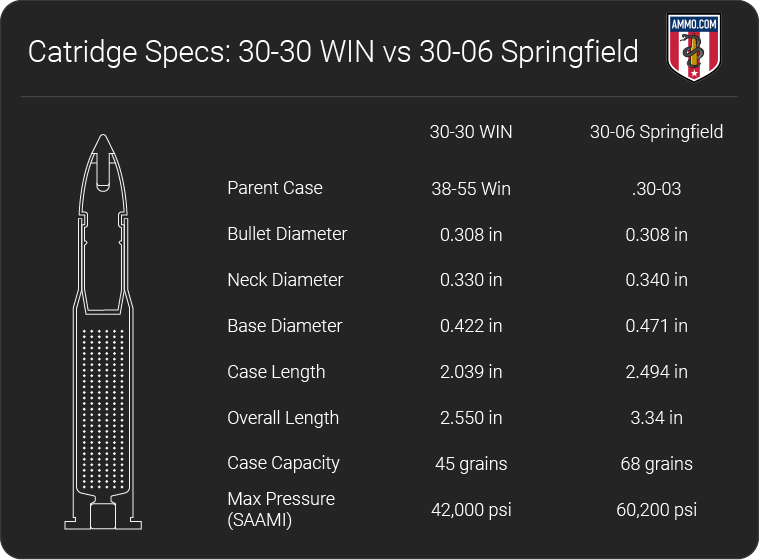
The first thing that you should notice is that both rifle cartridges fire the same bullet diameter, 0.308”. This is about the only similarity we will see when it comes to 30-30 vs 30-06!
The first major difference you’ll notice is the case length as the 30-06 dwarfs the 30-30 by over 0.4”. This drastic difference means that the action type for each cartridge will be different. As the 30-30 is a shorter case, it will fit into a short action rifle. This means that the distance the bolt needs to be thrown to eject the spent case will be shorter.
By contrast, the 30-06 has a longer case and fits into long action rifles.
In theory, a short action and shorter case “could” allow for faster follow-up shots as it takes less movement to eject a fired cartridge case from the chamber. However, with a little time working on your bolt throw at the range, most deer hunters will not notice any difference between a short action vs long action rifles in terms of reload speeds.
The next major difference is the case capacity of each cartridge. The 30-06 is a cavernous case that can hold 68 gr of propellant, while the 30-30 has about 30% less case capacity at 45 gr. This means that the 30-06 will be able to fire heavier bullets at a higher muzzle velocity than the 30-30.
Lastly, the base diameter for 30-30 is considerably smaller than 30-06 (0.422” vs 0.471”, respectively). This relates to both case capacity and the SAAMI spec maximum pressure. The 30-30 can withstand about 33% less pressure at 42,000 PSI as compared to the 30-06 at 60,200 PSI.
All that case capacity comes at a cost though…And that cost is felt recoil.
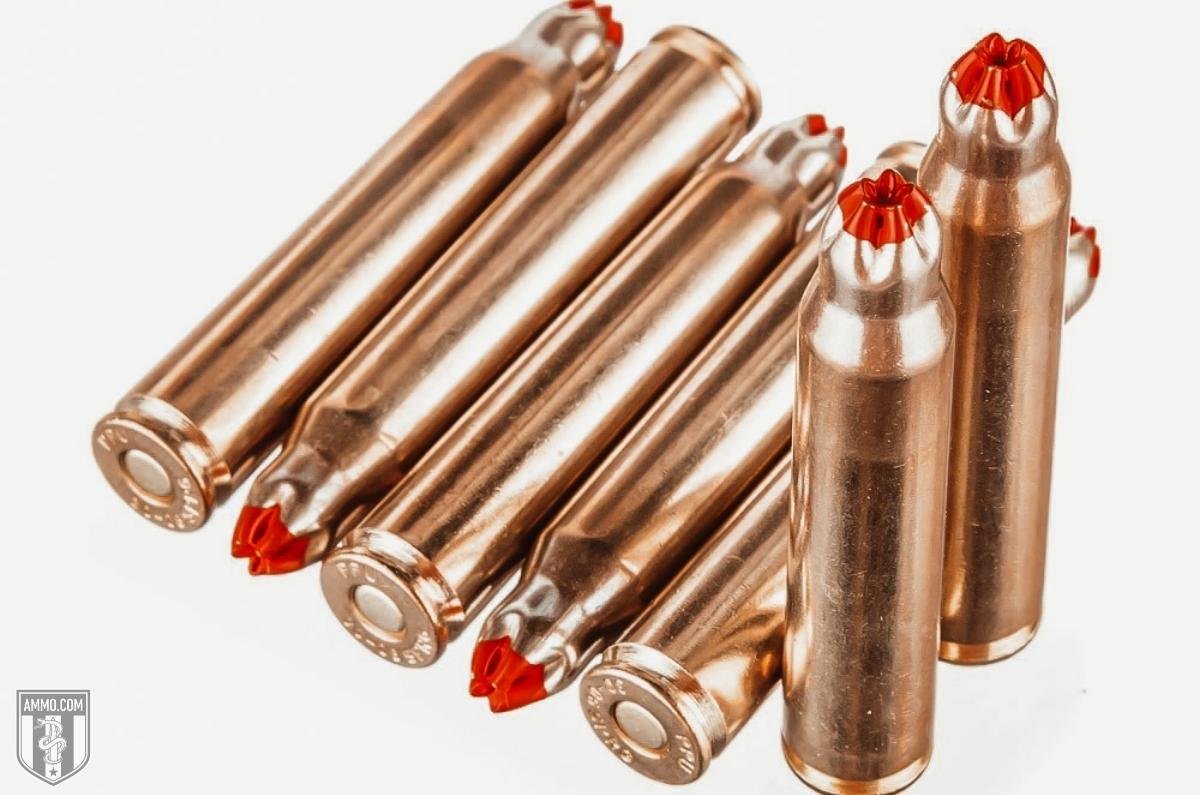
Recoil
When it comes to recoil, the 30-30 has considerably less felt recoil than the 30-06. The 30-30 was specifically designed to have less recoil than other hunting rounds of the day, such as the 45-70 Government.
As both cartridges fire the same bullet, we can do an apples-to-apples comparison. For this example, we will examine the Remington Core-Lokt with a 150-grain bullet as this is a popular loading for both cartridges.
Assuming a 7-pound rifle, a 150-grain Remington Core-Lokt fired in 30-06 will have a felt recoil of about 23 ft-lbs slapping your shoulder. In contrast, the 30-30 will only impart about 14 ft-lbs of force into the shooter. And trust me, when you shoot these two rifles side-by-side, you can tell the difference!
The reason for this drastic difference is due to the differences in case capacity and muzzle velocity. As the 30-06 has a longer case length and higher case capacity, the addition propellant will allow for higher muzzle velocity when compared to the 30-30, even though the bullet weight is the same.
In the example above, the muzzle velocity 30-06 is 2,910 FPS and 2,390 FPS for 30-30 according to Remington’s ballistic data.
Newton taught us in high school physics that every action has an equal and opposite reaction. Henceforth, as the bullet fired from the 30-06 has more force used to push it out the barrel at a higher velocity, it, therefore, must push back on the shooter equally hard.
Therefore the 30-30 will always have less recoil than 30-06 because 30-30 has a shorter case and less case capacity.
But does this matter? For many marksmen and hunters, it won’t.
As hunters rarely have long strings of fire, it is unlikely that recoil will be much of a deciding factor for seasoned whitetail stalkers.
However, for new or inexperienced shooters, heavy recoil can cause them to throw their shots as they anticipate the recoil. Therefore, for newer or recoil-sensitive shooters, the 30-30 is the obvious choice. But for those marksmen who have trained their fundamentals of shooting, the recoil of the 30-06 should not be an issue.
Trajectory
Trajectory is how we quantify a bullet’s flight path to its target measured in inches of bullet drop. As a bullet travels downrange, it is constantly being pulled back towards the earth due to gravity. And in terms of long range shooting, a flatter trajectory is preferred.
When comparing the 30-06 and the 30-30, the 30-06 reigns supreme when it comes to trajectory. Take for example the 150-grain bullet we discussed earlier, at 400 yards the 30-06 will experience a reasonable bullet drop of -19” while the 30-30 is crashing back to the earth with a bullet drop of -63”. That’s a difference of 44”, which is 3.66 feet. That can mean the difference between nailing a double lung shot on a whitetail deer at range or sailing the round well below his belly (or worse, injuring the animal).
This is primarily due to the bullet designs dictated by the tubular magazine of the 30-30. As pointed, more aerodynamic bullets cannot be used in the 30-30, less aerodynamic bullets like flat points or round noses must be utilized. These bullets will hemorrhage FPS downrange at a ridiculous rate. As the bullets slow down, the forces of gravity and air resistance have a more profound effect on their trajectory.
This makes the 30-06 the preferred cartridge for long range target shooting or hunting shots as it has a flatter trajectory and more aerodynamic bullets that maintain their velocity for greater distances.
Accuracy
Accuracy is a very subjective comparison point as it depends more on the shooting platform and the individual shooter more so than the cartridge itself.
There’s no denying that the 30-30 is an accurate cartridge, given its whitetail slaying legacy. However, we must call into question the effective range of the 30-30 and its general trajectory (as discussed above).
Looking at the ballistics tables below, we can see that within 200 yards there is very little difference in the trajectory between 30-30 and 30-06. However, the further you go downrange with the 30-30 the worse things get.
This is due to the massive loss in velocity experienced by the less aerodynamic 30-30 as it travels to the target.
The range at which a bullet goes below the speed of sound is referred to as its supersonic limit. For the 30-30, this is around 400 yards…that’s not very good compared to the 30-06 that can remain supersonic up to just over 1000 yards.
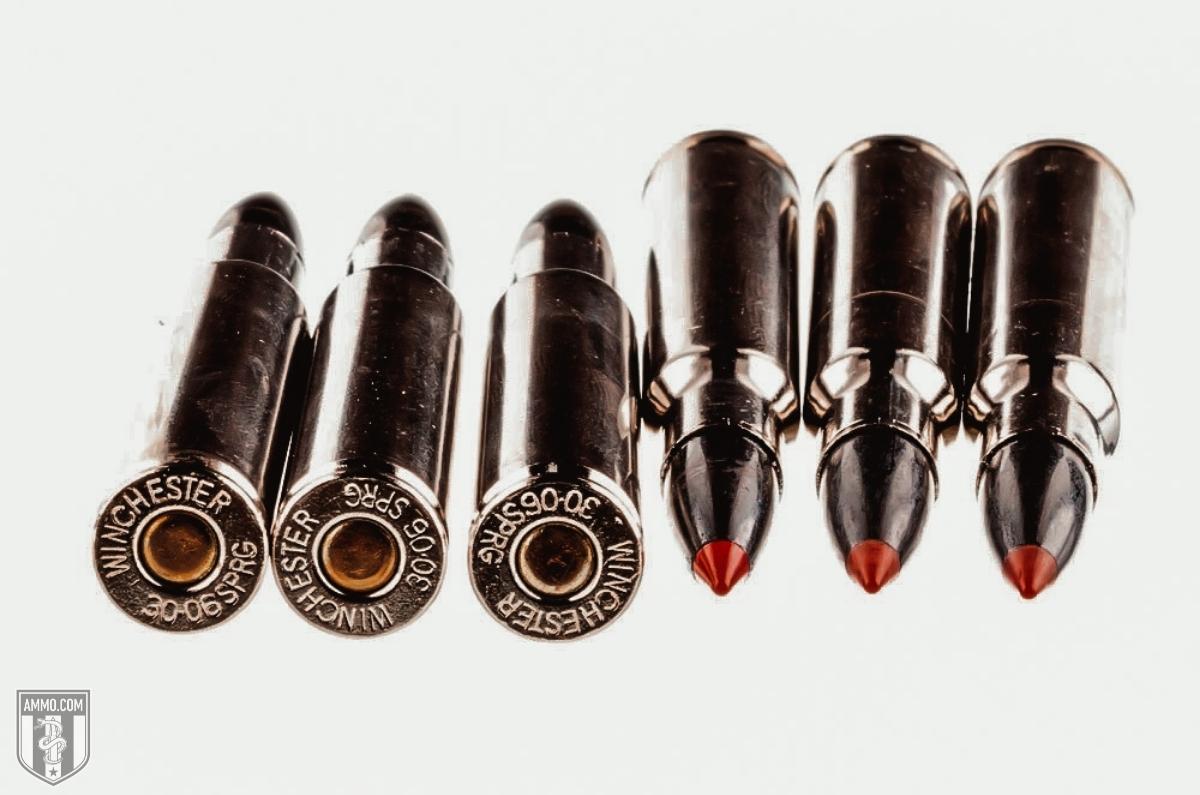
Once a bullet dips below the speed of sound, accuracy suffers considerably as the bullet is affected by environmental conditions (gravity, wind, air resistance) more.
Therefore, within 200 yards you should experience virtually no difference in accuracy. However, as the 30-30 begins to slow down faster once it passes 200 yards, the bullet drop calculations become considerably more difficult. This makes it more difficult to maintain accuracy over 300 yards for the 30-30.
At ranges over 300 yards, the 30-06 will be the more accurate cartridge. And the snipers of WWII will attest to that!
Ballistic Coefficient
Ballistic Coefficient (BC) is a numerical representation of how well a bullet resists wind and air resistance. It’s a measure of how aerodynamic a bullet is, a high BC is preferred and means the bullet will buck the wind easier.
The way a BC is calculated is rather complicated and irrelevant for this article, however, heavier bullets will typically have a higher ballistic coefficient.
As I’m sure you’ve guessed by now, the bullet design for 30-30 plays a huge role in its Ballistic Coefficient as they are generally less aerodynamic.
And this shows in the numbers as the 30-06 absolutely runs away with it in terms of BC. On average, 30-06 will have an SD of around 0.427 compared to 0.231 for 30-30, which is just short of being a 2x difference.
The 30-06 simply dominates in terms of Sectional Density, even though 30-30 fires the same bullet diameter as 30-06.
Sectional Density
Sectional Density (SD) is the measure of how well a bullet penetrates a target. This is extremely important when hunting big game, as you need a bullet that can punch through thick hide, bone, and sinew.
Sectional density is calculated by comparing the bullet weight and the bullet diameter, the higher the number the more effective it will be at penetrating a target. The higher the SD the deeper the bullet will penetrate the target.
As the 30-06 and 30-30 shoot the same caliber bullet, the only determining factor is bullet weight. If more penetration is needed, a heavier bullet should be used.
As such, Sectional Density is virtually identical between 30-06 and 30-30. Furthermore, it is unlikely a whitetail deer will be able to feel any minuscule differences in SD between these two hunting cartridges.
Hunting
And now we come to the biggest comparison of them all, 30-30 vs 30-06 for hunting.
When it comes to hunting, shot placement is the key to successfully and humanely harvesting a game animal. It doesn’t matter how many ft-lbs your bullet has, the exotic moon rock extruded propellant your handloads use, or what type of HALO-inspired projectiles you are using if your shot placement is terrible.
Effective practice at the range is the key to accuracy, so make sure that you can put the bullet where it needs to go when the moment of truth arrives.
Phew! Ok, we got that out of the way, now let’s talk hunting.
There’s no denying that the 30-30 is a North American deer hunting all-star cartridge as it’s been consistently sending whitetail to the freezer for well over a century.
However, there is one thing to consider when using 30-30 for hunting, and that’s its effective range.
As a rule of thumb, 1,000 ft-lbs of energy is needed to effectively harvest a deer. After looking at the 30-30 ballistics table below, I’m sure you can see the issue.
The 30-30 starts to come dangerously close to 1,000 ft-lbs of energy once it crosses the 200-yard marker. The one exception to this is the Hornady LEVERevolution. The LEVERevolution bullet uses an extremely flexible elastomer tip that is safe to use in tubular magazines. This allows Hornady to use more aerodynamic bullets for 30-30, extending its effective range to about 300 yards.
And how about the 30-06? Pfft! 200 yards is mere child’s play!
The 30-06 will still be way over 1,000 ft-lbs of force even past 500 yards, greatly extending the range of your hunting rifle.
But the big question is: “Does effective range really matter?”
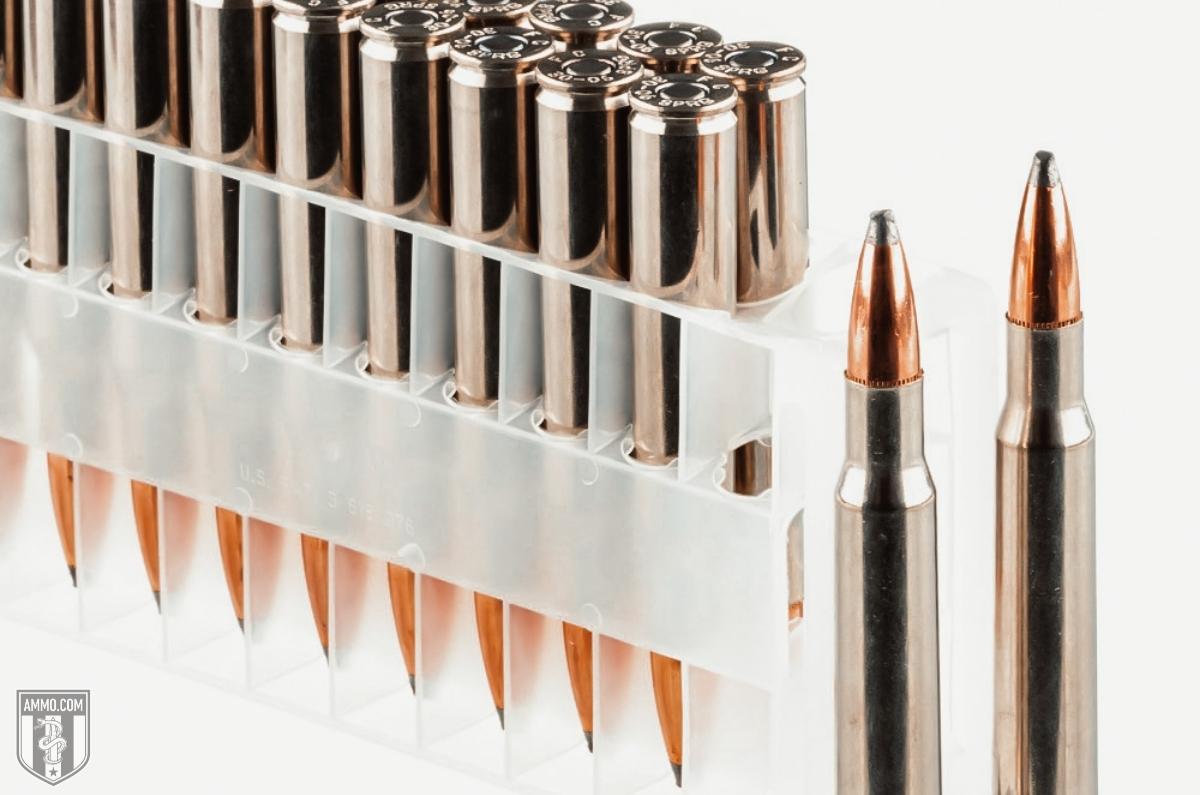
And the answer is, “It depends on where you want to go deer hunting.”
If you plan on hunting out of a tree stand in a heavily wooded area where 100 yards is considered a long shot, then 30-30 will be more than enough to meet your needs. However, if you’re going to be hunting mule deer up in Montana where 400+ yard shots are commonplace, then you’ll need to bring your favorite 30-06 hunting rifle to ensure you have enough range to claim your trophy.
Now let’s talk large game, and by that, I mean elk, black bear, and moose.
For black bear, conventional wisdom states that 1,000 ft-lbs is needed for a clean kill, the same as whitetail. For this, 30-30 and 30-06 are both sufficient provided you do your part.
However, elk and moose are something else entirely. For these large game animals, you’ll need to hit with 1,500 ft-lbs of energy for elk and 2,200 ft-lbs for moose. By these numbers, you’ll need to be within 100 yards to take an elk with 30-30. For moose, you’ll need to be at point blank range with a bit of a sprint towards the moose for some extra FPS (that’s not advisable).
However, this is where the numbers somewhat diverge from reality and actual field reports. Many Canadian hunters report taking moose with 1 shot of 30-30 every year. But by the numbers, this shouldn’t happen. Along that same line, I’m sure you’ve heard the stories of deer being taken with .22 LR as well.
When you hear stories like this, you must remember that it all comes down to shot placement. If you know exactly where you need to hit and you are accurate enough to do it, then I have no doubt you can take a moose with 30-30.
However, just because you “can” do a thing, doesn’t mean you “should” do that thing.
To that end, many states and territories have regulations requiring the use of specific calibers on certain large game animals. Always ensure that you are following all local and state hunting regulations whenever you head out into the woods (and yes, that means caliber restrictions too).
When hunting big game, the 30-06 is a clear choice as it offers the range, penetration, and stopping power you need to effectively harvest these large game animals. For these hunts, I’d recommend the 180 grain Barnes TTSX or Nosler Accubond Trophy Grade ammo for best results.
To summarize, the 30-30 is an extremely effective hunting round and is an excellent low recoil option for whitetail deer, mule deer, feral hogs, and black bears across North America. Engagement ranges should be under 200 yards to ensure you have enough ft-lbs of energy to harvest the animal humanely.
For large game, like elk and moose, the 30-06 is preferred as it brings more stopping power and FPS that allows you to engage at longer distances. Keen marksmen have claimed these game animals using the 30-30, but this is not recommended as it lacks the necessary ft-lbs of force to harvest larger game consistently and humanely. Furthermore, many local hunting regulations prohibit it.
Ammo and Rifle Availability
In terms of ammo availability, you will not lack options with either caliber. That being said, for 30-06, there are simply more varieties available.
This is due in part to the fact that the 30-06 was a military cartridge and the 30-30 never saw military service. This means that there is cheap, military surplus ammo for 30-06 available whereas only factory new 30-30 ammo is available.
Furthermore, more overall development has been dedicated to the 30-06 to further optimize the cartridge since its conception. After the 30-06 left active service in NATO and was replaced by the 308 Winchester, many ammo manufacturers were interested in maintaining the 30-06’s popularity as it was already an established sporting cartridge with untapped potential.
The result was that many advancements were made in 30-06 while the 30-30 remained mostly unchanged.
The fact that 30-30 was primarily relegated to lever-action rifles somewhat inhibited its development, as ammo manufacturers had to contend with the dilemma of the tubular magazine. This limitation in bullet design definitely hamstrung the 30-30’s development where the 30-06 could use basically any bullet design available.
As a result, there are about 3x more varieties of 30-06 ammo available than there is for 30-30. The 30-06 also has a wider variety of bullet weight options, ranging from as low as 100 gr for varmints to as high as 220 gr for moose and bears. The 30-30, on the other hand, is typically limited to 140-170 gr loadings.
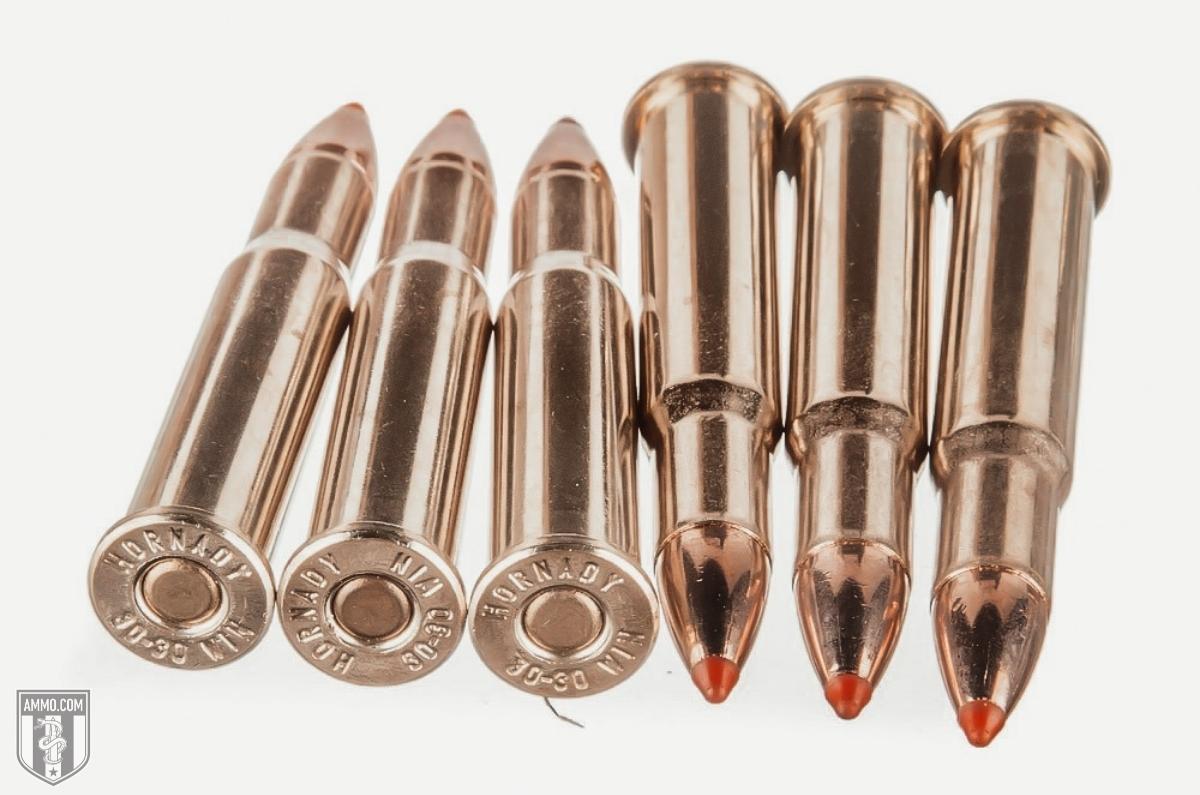
As far as ammo prices are concerned, the 30-30 will be marginally less expensive with cheap practice ammo coming in around $1.20/round as compared to 30-06 that can be had for about $1.50/round with current prices. Premium hunting ammo will be about double (or more) of the prices listed above.
Since we are on the topic of ammo cost, remember to check out our Winchester 30-06 ammo and Remington .30-06 ammo page for more ammo options.
In terms of rifles, the 30-06 offers a wider range of options than afforded by the 30-30. Due to the widespread military adoption of the 30-06, numerous surplus bolt action and semi-auto options are available for purchase at reasonable prices. Furthermore, modern firearms manufacturers are not sleeping on this timeless cartridge, and every major firearms retailer will have 30-06 rifle options available.
Some popular modern 30-06 rifles include:
- Savage 110 Hunter
- Remington 700
- Browning X-Bolt
- Ruger Hawkeye
- Winchester Model 70
The premium rifles listed above will run you about $700 and up given the current market pricing at the time of writing.
Budget rifle options are available for 30-06 for $500 or less such as the Mossberg Patriot, Ruger American, and Savage Axis.
For 30-30, you are mostly relegated to lever-action rifles. However, some single shot varieties are available as well, such as the Contender and Encore lines from Thompson Center. Popular 30-30 Rifles include:
- Winchester Model 94
- Marlin 336
- Henry All Weather Side-Gate Lever
- Mossberg 464
The models listed above will all run you around $900+ at the time of writing except the Mossberg 464, which starts around $500.
In terms of ammo and rifle availability, the 30-06 clearly has the advantage. However, there’s something whimsical about the 30-30 and a lever-action rifle that takes you back to the Wild West or pioneer living. So, I cannot fault you for going that direction as enjoying your hunt is just as important (if not more so) than the taking the animal itself.
Reloading
When it comes to reloading and crafting your own handloads for 30-06 and 30-30, you have many different bullets and powders at your disposal.
Both cartridges require a large rifle primer and they both fire the same 30-caliber bullets like the 308 Winchester and 300 Win Mag. Therefore, you could potentially craft handloads for 4+ different calibers and only have to purchase one caliber of bullet and primer size, which is very helpful if you like to stock up on reloading components.
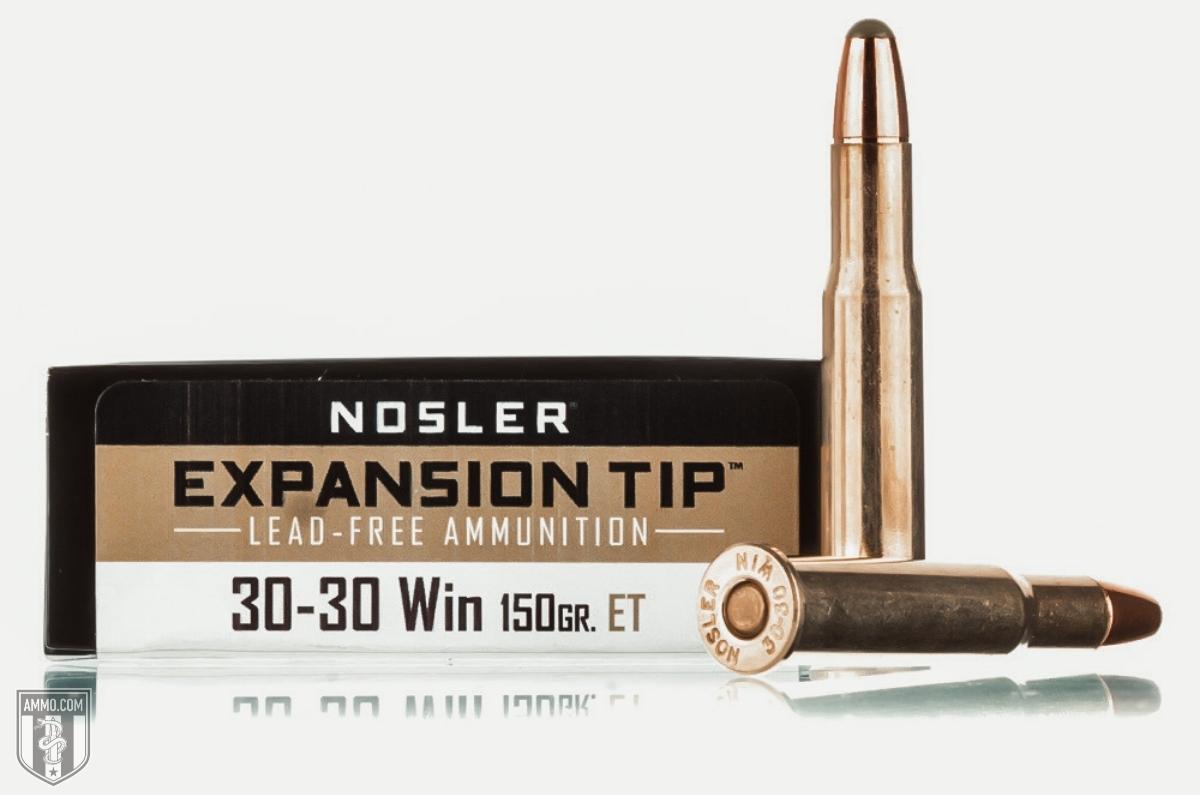
All the major bullet manufacturers have a plethora of 30 caliber projectiles for you to choose from in various bullet weights and designs. Manufactures such as Hornady, Nosler, Barnes, Federal, Sierra, and Speer are more than happy to keep your reloading table stocked with 30-cal bullets that will make short work of any game animal you’re aiming to hunt.
Reloading for 30-06 and 30-30 is a breeze and you can really dial in your handload to get that sub-MOA accuracy you need to win bragging rights at deer camp later this hunting season!
.30-06 vs .30-30 Ballistics
Our experts here at Ammo.com have tirelessly compiled a variety of manufacturers ’ ballistic data to share with you here. These tables compare various bullet weights and list their muzzle energy, muzzle velocity, and bullet drop rates from 0-400 yards.
.30-06 Ballistics
Note: This information comes from the manufacturer and is for informational purposes only. The actual ballistics obtained with your firearm can vary considerably from the advertised ballistics. Also, ballistics can vary from lot to lot with the same brand and type load.
.30-30 Ballistics Chart
Note: This information comes from the manufacturer and is for informational purposes only. The actual ballistics obtained with your firearm can vary considerably from the advertised ballistics. Also, ballistics can vary from lot to lot with the same brand and type load.
What is .30-30: A Brief History of an American Sporting Legend
The 30-30 Winchester is one of America’s oldest hunting cartridges and was developed and released by the Winchester Repeating Arms Company in their August catalog in 1895. The new round was chambered in their Winchester Model 1894 carbine and was marketed as a sporting cartridge.
The 30-30 is unique as it was the first small bore cartridge offered using smokeless powder.
The 30-30 Winchester is also known as:
- .30 Winchester Center Fire
- 30 WCF
- 30 Winchester Smokeless
The 30 WCF offered hunters excellent terminal ballistics in a compact, smooth package. Ideal for deer hunting and target shooting, the 30 WCF has remained extremely popular since its debut well into the modern era.
What does .30-30 Mean?
When Marlin adopted the 30 WCF for their model 336 lever action, they didn’t want to pay homage to Winchester as they were a rival gun manufacturer.
As such, they dropped “Winchester” off the name and simply called it the 30-30. Pronounced “thirty thirty”, this nomenclature harkens back to an older methodology of cartridge naming. The first “30” in the name refers to the bullet caliber used in the cartridge, while the second “30” refers to the 30 grains of smokeless powder that was used in the original design.
What Caliber is .30-30?
The 30-30 Winchester is a 30-caliber rimmed, centerfire rifle cartridge that fires 0.308” diameter bullets.
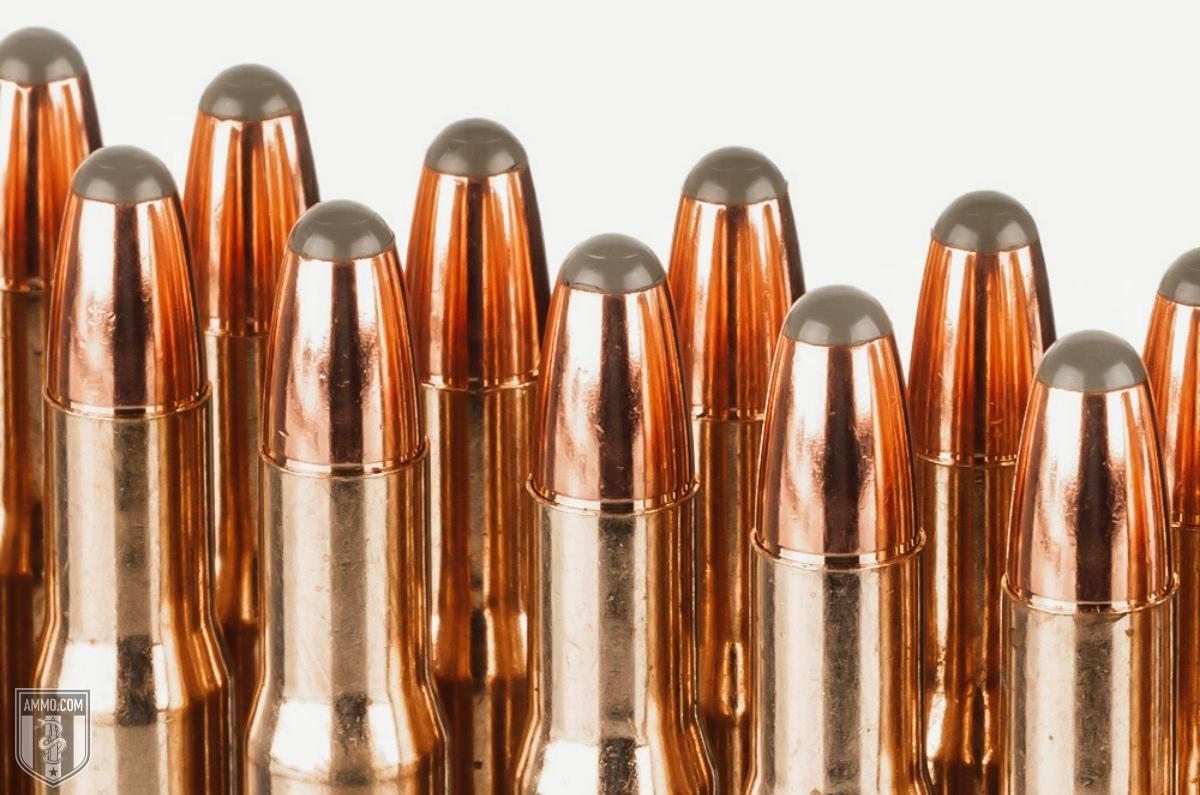
What is .30-06: The American Military Powerhouse
America’s love affair with 30 caliber rifle rounds began back in the Wild West with the introduction of the 30-30 Winchester. Later, the U.S. Army developed the 30-40 Krag to be its smokeless powder replacement for the .45-70 Government.
Around 1901, the U.S. Military started developing a new cartridge to replace the 30-40 Krag. The American Expeditionary Forces were very familiar with the effectiveness of the 7mm Mauser cartridge, suffering staggering losses at the hands of the 1893 Mauser at the Battle of Santiago during the Spanish-American War in Cuba.
It was clear that the 30-40 Krag was an inferior design compared to the Spanish Mausers and the military did not want to fall behind with advancements in bolt action rifle and cartridge technology.
At the time, heavier bullet weights were thought to be the superior ballistic choice. Therefore, the initial design submitted in 1903 used the same 220-grain round nose bullets fired by the 30-40 Krag.
The 30-03 Springfield was patterned after the famous 7x57mm Mauser cartridge, sharing identical case head dimensions.
However, it didn’t take long for the American generals to take note that multiple European nations were favoring higher velocity, Spitzer (pointed) projectiles in their new bolt action rifles. Not wanting to get left behind, the U.S. Military was quick to adopt a similar design. In 1906, the new cartridge that fired a Spitzer flat-based 150-grain bullet was submitted and accepted. The original design for 30-06 achieved a muzzle velocity of 2,700 fps, packed 2,429 ft-lbs of muzzle energy, and a maximum pressure of 60,200 psi (SAAMI specs). And thus the 30-06 Springfield was born.
Although the 30-06 initially gained popularity with the Army’s new bolt action rifle, the 1903 Springfield (which looked surprisingly similar to a Mauser…coincidence I’m sure), it truly became World Famous with the introduction of the semi-auto M1 Garand during World War II. Although the M1 Garand was the primary battle rifle during WWII, U.S. Military snipers still utilized a scoped variant of the 1903 Springfield for long range shots. This just goes to show how incredibly versatile the 30-06 was on the battlefield.
The 30-06 was the ammo carried by our soldiers who fought in the trenches on the Western Front in World War I, stormed the beaches of Normandy in WWII, assaulted the 38th Parallel in Korea, and saw limited use in the jungles of Vietnam.
Not only has the 30-06 seen massive success on the battlefield, but it has also seen immense commercial success in the civilian market. Soldiers returning home from war were extremely familiar with the 30-06 and sought to utilize it in the woods for deer and elk instead of against the nation’s enemies.
Big game hunters loved the amazing terminal ballistics and long range that the 30-06 offered while having a recoil impulse that is not overly punishing to the shoulder.
Since its introduction to the civilian market, the 30-06 has been the de facto hunting cartridge that all other hunting caliber cartridges are measured against. The most popular loadings for 30-06 range between 150 and 180 gr bullet weights with the 180-grain bullet being the most popular with big game hunters. However, specialty ammo can go as low as 110-grain bullets and as high as 220-grain projectiles.
The 30-06 is incredibly versatile, allowing hunters to customize their loads depending on the game animals they are stalking. Lighter bullet weights like the 150 and 165 gr Nosler Partition or Accubond can be utilized for whitetail or mule deer, while you should have good luck with the 200 gr Barnes TSX when you have a perfect broadside shot lined up on that trophy elk or moose in your crosshairs.
With proper loadings, the 30-06 can easily be used to fell moose and black bears. The 30-06 is truly a rifle cartridge of American legend and has survived the test of time, as it is still one of the most popular hunting rounds in the world over 100 years later.
To see how the .30-30 compares to other calibers, check out 45-70 vs .30-30.
What caliber is .30-06?
The 30-06 is a 30-caliber rimless, centerfire rifle cartridge that fires 0.308” diameter bullets. Many new shooters might not understand the naming scheme used for American cartridges and wonder what caliber 30-06 is.
The “30” designates the bullet caliber and the “06” (pronounced: aught six) designates the year of its adoption. The 30-06 Springfield can also be referred to as the 3006 Springfield or just simply as 30-06.
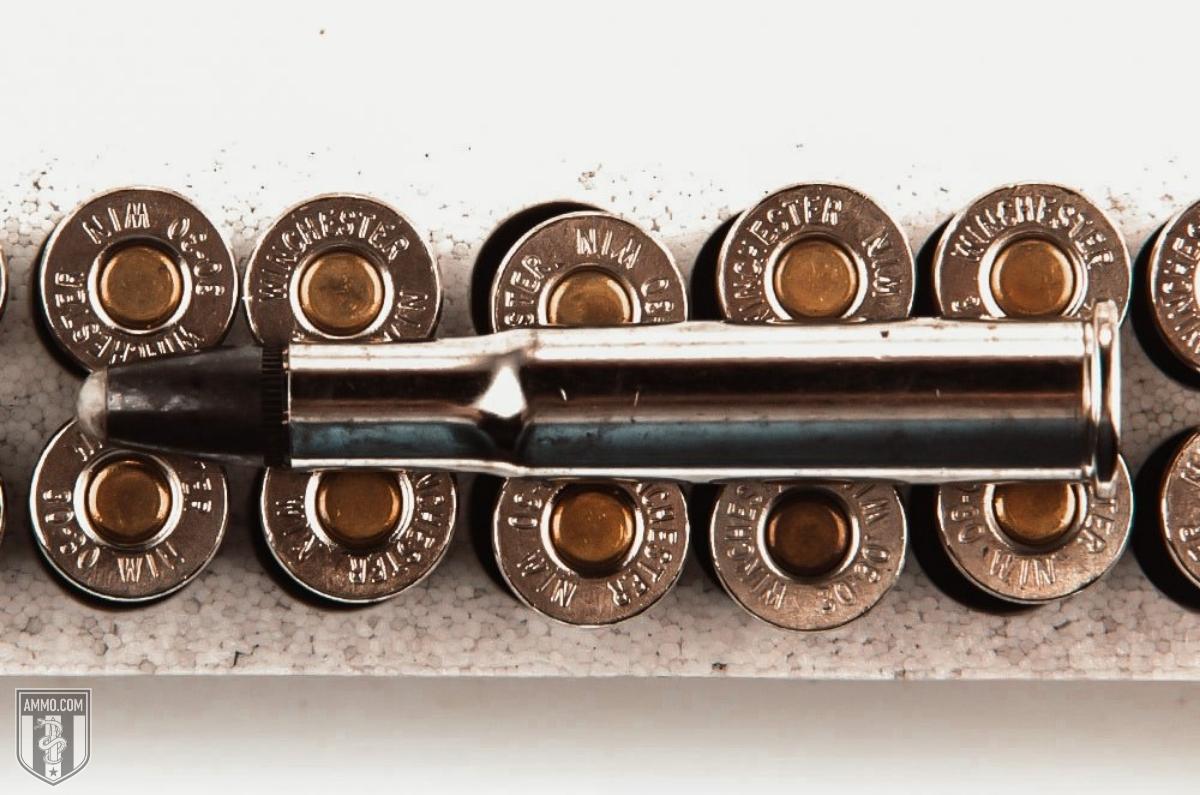
Final Shots: .30-30 vs .30-06
When it comes to classic deer hunting cartridges, the effectiveness of the 30-30 and 30-06 have proven themselves time and time again for well over 100 years. Their unparalleled success in the woods and the battlefield has kept demand for these two rifle cartridges extremely high and their popularity sees no signs of waning anytime soon.
The 30-30 Winchester was developed at the turn of the 19th century as a sporting cartridge that packed a lot of stopping power into a low recoil, lever action package. This allowed hunters to make quick follow-up shots that proved extremely effective at putting venison on the table and in the freezer. Furthermore, the nostalgia of hunting with a 30-30 lever-action rifle cannot be ignored and is often the go-to hunting rifle for many whitetail enthusiasts across North America.
The 30-06 Springfield was developed as an instrument of war and proved extremely effective for the United States and its allies during both World Wars. Although it has retired from the battlefield, the 30-06’s stopping power and long range capabilities have made it an ideal big game hunting cartridge that has harvested every four-legged animal across the North American continent. The versatility of the cartridge has allowed it to be applied to multiple hunting situations and even modern hunting rounds cannot overcome the popularity and raw stopping power offered by the timeless 30-06.
But which of these 30-caliber hunting calibers is right for you? That will depend on your typical hunting ranges and what animals you plan on stalking.
The 30-30 excels at ranges below 200 yards and is right at home in dense woods and brush when carrying a heavy and long hunting rifle would be less than ideal. Lever-action rifles in 30-30 offer a tight, slick package that is easy to handle, with minimal recoil, and hard-hitting terminal ballistics. The 30-30 is ideal for deer and black bear at ranges below 200 yards, however, if you anticipate shooting longer distances or larger game such as moose and elk, you should consider switching to a 30-06.
Whichever rifle cartridge you choose, make sure you know the effective range and plan your hunts accordingly. Shot placement always trumps ballistics, so knowing where your bullets are going to hit is the key to success in the field.
As always, make sure you flex your 2A Rights and I’ll see you on the firing line or in the tree stand this fall!


